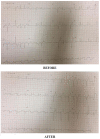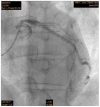AMI and Anabolic-Androgenic Steroids: Case Report with Systematic Review
- PMID: 33390145
- PMCID: PMC8950448
- DOI: 10.2174/1573403X16999201231203405
AMI and Anabolic-Androgenic Steroids: Case Report with Systematic Review
Abstract
Introduction: Coronary artery disease (CAD) represents approximately 390 thousand deaths per year in Brazil and is associated, among other predictors, with the use of anabolic and androgenic steroids (AAS).
Objective: To analyze a clinical case of a patient who suffered AMI after abuse of AAS. A systematic literature review has been carried out to physiologically analyze the main factors that can lead to AMI with the use of these hormones.
Methods: The EVR patient, 41 years old, denies any comorbidities or use of medications. He has been admitted to the emergency room due to typical angina-precordial pain in tightness associated with eventual back pain and paresthesia of both upper limbs, after intense physical effort at the gym, without improvement at rest, and with partial improvement after first care at the health unit. The patient was hypertensive in an emergency bed after the occurrence of ST elevation. The patient alleges the use of anabolic steroids for one month. The patient presented with obstructive atherosclerotic coronary artery disease with total occlusion of the anterior descending artery. Systematic review: A total of 89 clinical studies have been compared and submitted to eligibility analysis, with 50 studies selected, according to the PRISMA rules.
Results: Long-term consumption of AAS may cause pathological changes, however, AAS can increase protein synthesis, muscle growth, and erythropoiesis.
Conclusion: Abuse of AAS has a toxic cardiovascular effect, which significantly increases the incidence of cardiovascular diseases.
Keywords: Anabolic-androgenic steroids; EVR.; acute myocardial infarction; angioplasty; atherosclerosis; cardiovascular disease.
Copyright© Bentham Science Publishers; For any queries, please email at epub@benthamscience.net.
Figures



References
-
- World Health Organization (WHO). The top 10 causes of death. Available from: http://www. who.int/mediacentre/factsheets/fs310/en/accessed in 09/10/2019.
-
- IBGE- Instituto Brasileiro de Geografia e Estatística. Available from: http://www.ibge.gov.br.
Publication types
MeSH terms
Substances
LinkOut - more resources
Full Text Sources
Medical
Miscellaneous
